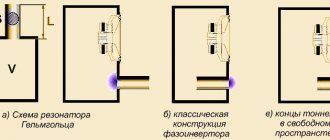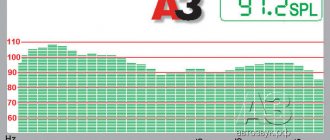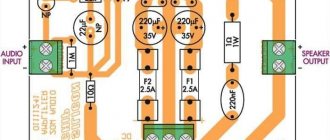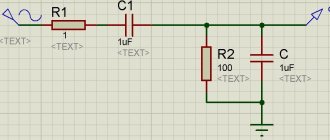The acoustic characteristics of the room where sound is reproduced affect the frequency response of sound pressure, and therefore the quality of reproduction. The same equipment will sound different in different rooms. Acoustic features include: the shape of the room, its volume and the sound absorption coefficients of the surfaces enclosing the room (ceiling, floor, walls). For example, curtains, carpets, upholstered furniture, etc. have a high sound absorption coefficient, while a smooth ceiling and walls absorb very little sound and largely reflect it. The ideal sound absorber is an open window. Sound absorption A is proportional to the area of the absorber S and its sound absorption coefficient α .
Any room (hall, auditorium, room) is an acoustic resonant system with distributed parameters, possessing a number of natural resonant frequencies. When sounds containing components of resonant frequencies are excited in a room, resonant air vibrations occur inside the room. This leads to amplification of sound at resonant frequencies and a change in the spectral composition of the sound signal, i.e. to change its timbre.
Reflection of waves from the walls of a room causes the formation of standing waves. They greatly disrupt the homogeneity of the sound field. Areas with maximum and minimum sound pressure appear in it - antinodes and nodes. Standing waves are formed both between parallel surfaces that limit a room, and in oblique directions of propagation of sound waves. However, waves of the first type (the so-called axial modes) are of greatest importance in the formation of a sound field in a room, especially small ones. The first (axial) frequency of natural vibrations arising between parallel surfaces is equal to:
fр1 = 172/l
- l – distance between bounding surfaces, m.
Thus, the lowest natural frequency is determined by the largest size of the room, usually its length. For example, at the greatest distance between walls of about 3.4 m, the natural frequency is 50 Hz. The most unfavorable room for listening is a room shaped like a cube, since it will have the same fundamental resonant frequency and its harmonics in all three directions.
So, in any room there are many natural vibrations. At the same time, in the region starting from the lowest natural frequency, the density of the spectrum of natural oscillations is relatively small, but with increasing frequency it increases sharply. Therefore, for not very small rooms, starting from a frequency of 150-200 Hz, the density of the spectrum of natural oscillations is so high that the phenomenon of resonance is imperceptible. A large room is more favorable for sound reproduction, since the main resonant frequencies decrease with increasing its size and are outside the operating frequency range, and harmonics, due to their large number, form an almost continuous spectrum and do not emphasize the sounds of individual frequencies. It is desirable that the volume of the room is at least 42 m3, and one of the linear dimensions is at least 5 m.
An effective means of improving listening is the presence of sound absorbers in the room, which reduce the reverberation time. In theaters, cinemas, and concert halls, sound absorbers are used to cover the ceiling and upper parts of the walls.
In living spaces, sound is absorbed by soft things, including furniture. Of course, the listeners themselves find themselves in the role of sound absorbers, and the degree of absorption in the room depends on their number.
Let us point out that the sound absorption coefficient α is equal to:
- for one listener = 0.38
- carpet = 0.35
- curtains = 0.5
Unfortunately, sounds of low frequencies are absorbed by most sound absorbers to a lesser extent than sounds of medium and especially high frequencies. It is quite difficult to satisfactorily dampen a room at lower frequencies.
Rice. 1 – Dependence of the optimal reverberation time of a room on its volume:
For home monophonic listening, a room with a reverberation time of 0.6-0.9 s is considered satisfactory (for stereophonic 0.4-0.5 s). The larger the volume of the room Vп , the greater the reverberation time can be while maintaining good conditions for sound reproduction. In Fig. Figure 1 shows the dependence of the optimal reverberation time of the room T on its volume Vп . To visualize the dependence of the sound pressure created by a loudspeaker in a room (at the location of the measuring microphone), Fig. 2 shows the frequency characteristics of a high-quality loudspeaker measured in a room and a sound (attenuated) chamber. As you can see, at frequencies below 400 Hz the response in a normal room is very uneven (dashed curve), while in the sound-measuring chamber, where all enclosing surfaces have a high sound absorption coefficient, the frequency response is smoothed out (solid curve). The shape of the frequency response recorded in a room is highly dependent on where the microphone and speaker are installed.
Room acoustics, tips and subtleties of tuning, article. Portal “www.hifinews.ru”
The acoustic properties of a room make a certain contribution to the quality of the sound panorama perceived by the listener. Not everyone has special rooms designed exclusively for installing high-end audio equipment. But for those who listen to music in an ordinary living room, there are many tips and notes, following which you can optimize the sound of your existing audio equipment.
Save and read later -
The acoustic properties of a room make a certain contribution to the quality of the sound panorama perceived by the listener. Not everyone has special rooms designed exclusively for installing high-end audio equipment. But for those who listen to music in an ordinary living room, there are many tips and notes, following which you can optimize the sound of your existing audio equipment. But we'll talk about this a little later. First, let's outline the initial data for solving our problem. Specially constructed, acoustically optimized halls, as a rule, have the shape of an irregular parallelepiped, with side walls that are not parallel to each other, and the ceilings, as in theaters and concert halls, are made in the shape of a slope. A standard room has a classic rectangular shape, which allows radiated and reflected sound waves to overlap each other. Depending on the materials used in construction and decoration, the acoustic properties of rooms of the same volume and shape can vary greatly. If your listening environment uses solid concrete wall and floor structures, they will help reflect the radiated sound. Plasterboard panels or wood siding will absorb most of the sound energy. With this in mind and using the following tips, you can improve your audio quality.
Before getting started, it is strongly recommended that you study some good reference book on acoustics. It may be quite difficult for beginners to understand the theory of sound wave propagation. But the acquired knowledge will pay off handsomely and will help you equip the room more competently, get the optimal sound space for listening from your room, and better understand the features of the distribution of the sound field. So, if you are not a trained acoustician, look for a good book that is accessible to your level of understanding to expand your knowledge with lots of useful, engaging information to digest.
One of the biggest problems that I see when communicating with my friends and acquaintances is excessive attention to the acoustics of the room. Of course, room acoustics are important, but they should be the last element you pay attention to after arranging your audio systems and choosing the optimal listening position. Proper placement of loudspeakers in a room will have a much greater effect than eliminating acoustic defects in the room. Take the time to arrange your audio speakers and find the ideal listening spot. Once you have done everything possible to make the music sound “right”, consider that you have completed 90% of the work and now it is time to create favorable acoustic conditions. Consider room acoustic preparation as the icing on the cake. Again, in our conditions this will be the simplest correction of room acoustics. Those interested in a deeper understanding of the impact of room features on sound should turn to serious sources on acoustic topics.
According to the acoustic properties, all rooms can be divided into three main types: ringing; dull and neutral rooms. As a rule, we want to have a room with neutral acoustic characteristics, which tends a little towards the ringing type. A ringing room has a long reverberation time. Reverberation is the process of sound intensity fading as it is repeatedly reflected. Each of us has at one time or another found ourselves in a loud room. Imagine a large dining room or hall where echoes roam and sounds seem ringing. Acoustic energy does not leave such a hall, but is reflected from the walls and ceiling and reaches the listening point, where part of it is picked up by our ears. If you have a room decorated with hardwood, with tiled floors, and virtually no soft materials in the decoration, you understand what a ringing (booming) room is. Stand in the middle of the room, clap your hands and listen. The sound of the clap turns into an echo and lasts for some time after the clap. This is reverberation and the effect of attenuation of acoustic energy. Such a room will require finishing materials to absorb reflections at medium and high frequencies in order to tame excess acoustic energy.
A silent room is the exact opposite of a loud room. Sounds will generally be muffled and if you do the same test with clapping your hands, you will notice that the sound fades even before you stop clapping. Closed rooms are typically carpeted, heavily draped, and have virtually no reflective surfaces. The room for listening to music should be neither deaf nor loud. We need something in between, a room that is generally neutral in terms of acoustic parameters, and which is still closer to the ringing type.
The reason we want an acoustically neutral room is that the real world is a combination of absorptive and acoustically resonant surfaces. It is necessary to achieve such acoustics in the room that the sound is not excessively absorbed by interior elements and, at the same time, is not completely rejected to us.
If your room is too dark, to achieve a more natural sound, look for opportunities to replace parts of fabric draperies or carpeting that absorb acoustic energy with a different finish. If the room is too loud, then, as a rule, it is much easier to determine the reflection points to suppress the reverberation effect.
Let's assume that you have a standard-sized room in an apartment or separate house. If it is possible to use it specifically for a home theater, you can contact specialists in acoustic finishing of premises so that they can help you best adjust its acoustic characteristics.
Defining Reflection Points
Fortunately, correcting the acoustic properties of a room in the mid and high frequencies is quite simple and relatively inexpensive. Depending on its size, for $200 - $500, you can adjust the acoustic characteristics of your room yourself. First, you will have to determine the reflection points before purchasing finishing materials to treat such areas.
All you need is a small mirror (at least 30 x 30 cm), the help of a friend or relative, and some sticky tape or a pencil (if you don't mind marking the walls). Again, this should only be done after the optimal and final placement of the audio speakers.
Have your assistant hold the mirror at ear level and move it along the plane of the wall while you sit at the listening position. On the side walls of the room to your left and right there will be primary and secondary reflection points relative to your position, two on each side. You must sit and monitor the mirror moved by an assistant along the left wall until you see the tweeter of the left channel audio speaker in the mirror. This will be the first reflection point. Have a helper mark the location on the wall with a pencil or marking tape. Now the mirror should slide further along the left wall until you see the tweeter of the right channel audio speaker, mark this place as well. Likewise, do the same for the right wall. Now you have two reflection points on the right and left walls of the room.
The same reflection points are on the ceiling and floor. Today, many people have hard reflective floors with carpeting or a separate rug. In this case, the reflection points on the floor can be completely neglected. If you have a hard floor without carpet, you can place a rug in front of the audio speakers to combat reflections from the floor. Not everyone has suspended or suspended ceilings in their rooms. Some people may even prefer a classic room with a stone ceiling. In this case, you will need to mark two places for acoustic treatment on top. Ask your assistant, standing on a stepladder or chair, (please be sure to take all safety precautions!) while holding the mirror, move it along the plane of the ceiling until you see the left channel tweeter in it, mark this place, and do the same for the right channel. You don't have to worry about the back or front wall of the room just yet.
Now you have marked reflection points that can easily be treated with sound-absorbing (mid- and high-frequency) material. Remember, acoustic panels do not absorb frequencies below 300 Hz (usually, although there are exceptions), so reflection points allow you to control clarity, ringing and reverberation.
Use sprayed acoustic coating sparingly, especially since it is quite expensive. Add layer by layer little by little until you reach the desired acoustic state of the room. You don't want to go overboard and create a dull room that will suck the freshness and energy out of your audio system. If you initially have a dark room, you will have to remove thick curtains, carpets and other interior elements until you achieve transparent sound. Special panels and a variety of improvised means, even cellular egg packaging, are also used as sound-absorbing materials. There will always be suitable materials, it’s just a matter of disrupting the aesthetics of the room.
Determination of room acoustic resonances
Each room has acoustic resonances or, as they also say, room modes (English Mode). The proportions of the room, i.e. The ratios of length, width and height determine the location of resonances in the frequency spectrum. Thus, the geometric dimensions of the room determine the frequencies at which resonances will occur when listening to music, i.e. individual frequencies that are of great importance for the music being reproduced will either be overly amplified or suppressed at certain points in the room.
The best way to determine acoustic resonances and standing waves (low frequencies tend to spread, reflect and overlap each other) in a room is to use special software. Professional software is quite expensive and requires the installation of microphones and subsequent analysis of the acoustic characteristics of the room. If you have such a program for calculating acoustic parameters, you should certainly use it. But if you just want to get a general idea of how your room interacts with the system, you can use simpler programs, also known as acoustic calculators. The original article suggests using https://amroc.andymel.eu.
One of the Russian-language simplified options (Axial Mode Calculator) can be found at https://www.acoustic.ua/forms/calculator8.html, it provides a simplified analysis of longitudinal acoustic resonances (axial modes) in a room. The acoustic calculator allows you to construct resonance graphs based on the size of your room as sound waves propagate along, across and along the height of the room. If several room resonances coincide in frequency (the interval between them is zero), then such modes (resonances) are called degenerate. In this case, a pronounced peak is usually observed in the amplitude-frequency response. Problematic frequencies will be highlighted in red in the program interface.
If two resonances (modes) are separated by an interval of 20 Hz or more, then such modes are called isolated. In this case, a pronounced “failure” is usually observed in the frequency response of the room. Problematic intervals will be highlighted in orange.
These peaks with dips in the frequency response give unwanted color to the sound of vocals and music. They are especially noticeable in the frequency range 95-175 Hz. Static sound peaks occur at different points in the room, depending on the position of the speakers, the size of the room and the sound frequency. You can identify such peaks by moving around the room and listening to low-frequency sound. As soon as you enter the standing wave zone, there is a lot of bass, but in other places there is almost none, localization is lost and the clarity of the bass turns into a simple “thump”.
At frequencies above 300 Hz, the influence of room resonances on the tonal balance can already be neglected. It is assumed that based on the graph in the longitudinal plane and the height of the room, it is possible to choose the optimal place both for placing acoustic emitters and a place for the listener. And, in addition, based on the obtained data on peaks and troughs, adjustments are also made to the acoustic characteristics of the room, which is much more complicated than installing sound-absorbing coatings at reflection points to correct the rest of the sound range. This set of measures may include both simple measures, such as securing pillows in the corners of the room, and installing special “bass traps” (such as a Helmholtz resonator) to level the lower part of the room’s frequency response. Unfortunately, some of these methods require a lot of space and are not applicable in a small room due to lack of space for them. Ideally, you should have a listening room with a volume of more than 40 cubic meters, then it will be much easier to adjust the acoustics of the room.
There are many great solutions out there, many of which are actually cheaper than building your own devices. But if you want to do the acoustic arrangement of a room yourself, to thoroughly understand its features and capabilities, then this is the topic of a separate article, and more than one.
The material was prepared based on materials from theabsolutesound.com project (translation from English - hifiNews.RU)
Prepared based on materials from the portal “www.hifinews.ru”, October 2014
www.hifinews.ru
This article was read 38,445 times
The article is included in the sections:
Useful tips
Rice. 2 – frequency response of the acoustic system (solid line – in the control room, dotted line – in the room):
The sound pressure level developed by a loudspeaker or acoustic system at lower frequencies increases by about 4 dB when installed in the corner of the room. However, with small room sizes, the “coloring” of the sound becomes unpleasant (a “mumbling” occurs) and the unevenness of the frequency response in the low-frequency region increases. The optimal position of the system is found after several trials.
A good place in a rectangular room would be a short wall with a 0.5 m indentation from the corners. It is useful to have a sound-absorbing covering (carpet, draperies, etc.) on the wall opposite the speakers. Also helping to reduce unfavorable room acoustics will be an equalizer , the effectiveness of which is shown in Fig. 3. But the equalizer has two disadvantages: 1 – you need to have a reserve of amplifier power at low frequencies; 2 – the need to measure the initial frequency response of the system in the room.
How is speaker volume measured?
It is measured in decibels (dB), as opposed to power, which is measured in watts. Decibel is a relative value and indicates how much the current SPL level exceeds the hearing threshold (0 dB).
Interesting materials:
Which village in the Vladimir region served as the setting for the story by Alexander Isaevich Solzhenitsyn, Matryonin Dvor? Which card is valid worldwide? What team in minecraft to make survival? Which constitution lasted the longest? What human actions relate to nature conservation? What actions constitute crimes against humanity? What actions can antivirus programs perform? What are the actions on vectors? What actions should you take when receiving a storm warning? What actions in The Sims improve your Charisma skill?
Example
To reproduce sound in a room with a volume of 51 m3 (area 17 m2, height 3 m) at the sound intensity level corresponding to a large orchestra, a loudspeaker and amplifier with nominal powers from 4 W to 10 W are required.
The power value obtained by calculation refers to the broadband head. The power of low-frequency and high-frequency heads in a 2- or 3-band system at different frequencies of the section fzd can be determined from the curves in Fig. 5, constructed from the above data on the distribution of the current power of natural sound at the output of low- and high-pass filters. The power of the narrowband drivers is determined by multiplying the calculated power value of the full-range loudspeaker by the relative power value for the selected crossover frequency. Very high sound levels have a detrimental effect on hearing.
Difference in power ratings
The technique has two power characteristics - peak and continuous. The first is not so important when choosing, since it indicates the ability of the equipment to operate for a minimum time at high peak loads. And the second, precisely, characterizes the ability to produce a sound of a certain strength. This is an indicator of how the speakers will sound with different types of sounds throughout the main playback time. In order to have equally enough power when playing voice and music, it is better to take it with a reserve. That is, multiply the power you need by two and look for this figure in the documents for the columns. You'll get the speaker power you need for an event or personal home use.











